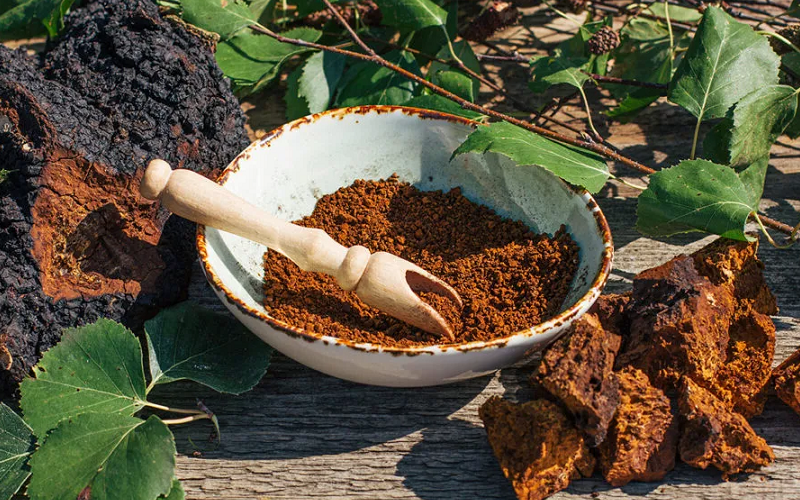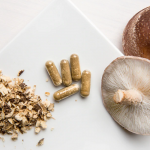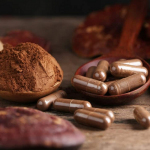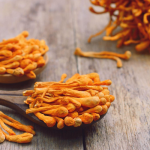The chaga, which looks more like a dark, dense clump of dirt than a mushroom, has been used in botanical and folk medicine for centuries in Russia, Northern Europe, and a scattering of other locales worldwide. Harvested from the living birch trees on which it grows, this fungus is thought to have such powerful health properties that it has been referred to by many as the King of Herbs.
Contents
What Are Chaga Mushrooms?
The Russian word for mushroom — czaga — is the origin for the chaga (pronounced cha-ga) name of this mushroom that grows in the cold climate parts of Russia. Chaga mushrooms also grow in other parts of the northern hemisphere, including Alaska and Northern Canada.
Chaga mushroom (scientific name Inonotus obliquus) grows on birch trees, and may take a decade or more to fully mature into the odd-looking dark mass that’s particular to this type of fungus. The hard, woody mass, or conk, attaches firmly to a birch tree. While externally dark and firm with a charcoal-like appearance, internally the large, 10 to 15 inch across mushroom is orange and soft.
Chaga, also known as cinder conk, birch canker polypore, clinker polypore, or black mass, is parasitic — it leaches nutrients from the host birch tree and gives back nothing of value to the tree. The chaga’s nutrient-robbing behavior may be bad for the tree, but it’s of benefit to us humans who consume the mushroom — the many antioxidants and other compounds of the chaga have made this species of mushroom a popular staple of traditional medicine in areas of the world where the mushroom grows.
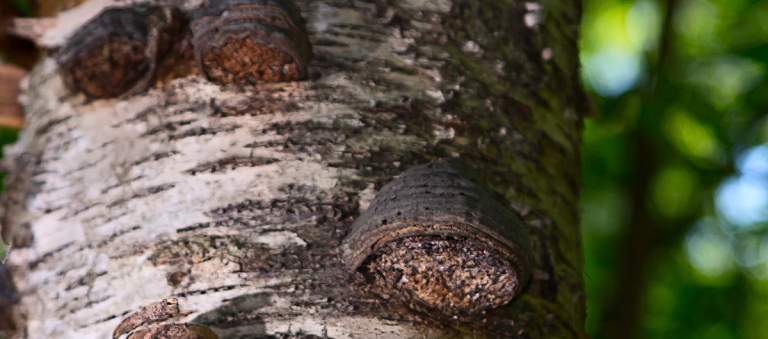
Health Benefits of Chaga Mushrooms
The chaga is extremely rich in antioxidants, which is one reason this mushroom provides so many health benefits. ORAC, which stands for oxygen radical absorbent capacity, is a measure of the antioxidant activity of a food. The higher the ORAC score, or value, the stronger the food’s ability to fight the destructive effects of oxidants, or free radicals. Chaga’s ORAC value of 52,000 makes it one of the ORAC rated foods. That score is 30 times higher than blueberries — a fruit that’s considered by health enthusiasts to be one of the best antioxidant foods. This crazy high ORAC value is one reason many people categorize chaga mushrooms as a superfood.
In addition to being rich in antioxidants, chaga mushrooms contain other healthful compounds including polysaccharides and triterpenes. We have more to say about these two compounds just ahead.
Chaga Fights Inflammation and Boosts the Immune System
When people think of inflammation, there’s often a knee-jerk reaction to assume inflammation is always a bad thing. But inflammation has a positive purpose — if it didn’t, it’s unlikely that the body would ever produce it. Inflammation is the immune system’s natural protective response that occurs in reaction to many types of illness. Inflammation is a useful defense mechanism that fights against infections.
Inflammation is very beneficial as a short-term weapon to fight infection. It’s when inflammation sticks around long-term that it becomes an enemy of the body. When inflammation becomes a chronic condition, it can damage the body by contributing to the development of conditions such as rheumatoid arthritis, autoimmune diseases, heart disease, and even depression.
Chaga mushrooms, like turkey tail mushrooms, have the ability to lessen inflammatory events by adjusting the body’s levels of cytokines. Cytokines are a type of protein molecule that serve as the immune system’s chemical messengers — they are what allows cells to “talk” with one another to stimulate the immune system to take action to attack tumors or fight off foreign pathogens (microorganisms that can cause disease). Cytokines play a key role in the immune system’s first line of defense — the stimulation of white blood cells.
As is often the case, too much of a good thing can turn into a bad thing. Here, too much cytokines production results in an overactive immune response leading to excess inflammation. Chaga has the effect of increasing cytokines to fight infection, but also limits that increase such that there isn’t an excess of cytokines traveling throughout the body. At the same time, chaga reduces the body’s release of two other inflammation-related substances that can be produced too abundantly — prostaglandin E2 (PGE2) and nitric oxide (NO).
Another chaga health benefit that has to do with white blood cells and the immune system is the mushroom’s beta-glucan content. Beta-glucans are soluble fibers that are carbohydrates present in the cell walls of some yeasts, bacteria, and fungi — including chaga mushrooms. Beta-glucans are immunomodulators — they strengthen and train the immune system’s response to pathogens. In particular, beta-glucans improve the functioning of macrophages and neutrophils — important types of white blood cells that protect the body from infection.
Chaga May Be Beneficial in Preventing and Fighting Cancer
Globally, cancer is the primary cause of death — so for decades there has been an ongoing search for effective treatments. Included in this search are chaga, primarily because the polysaccharides in this mushroom may have anti-tumor effects.
Monosaccharides are simple sugars, such as glucose. Polysaccharides are larger molecules that consist of many small monosaccharides. Polysaccharides have antiviral and antibiotic properties but in terms of cancer prevention and treatment their most important trait is their anti-tumor properties. Polysaccharides are capable of inducing apoptosis in tumor cells — apoptosis being the programmed death of a cell.
Other anti-tumor compounds present in chaga are various types of triterpenes. Triterpenes, also known as triterpenoids, are antioxidants that provide a wide range of health benefits — they’re antiviral, anti-inflammatory, neuroprotective, and anti-tumor. Studies show that the triterpenes in chaga can kill tumor cells while not causing harm to normal, healthy cells.
Chaga contains many triterpenes, the most important of which may be betulinic acid. Betulinic acid is produced in the chaga from betulin that the mushroom leeches from its host birch tree. In humans the converted betulinic acid is more biologically active than the betulin present in the birch tree, so getting this triterpene from the mushroom is more beneficial than harvesting it from the tree.
Chaga Lowers Cholesterol
Cholesterol is a fatty, wax-like substance present in every cell of the body. The body uses cholesterol to make hormones, vitamin D from sunlight, and several other compounds. Too much cholesterol, though, can end up combining with other compounds in the blood and forming plaque — cholesterol buildup that can block arteries.
Chaga’s high concentration of antioxidants are believed to help reduce LDL cholesterol and increase HDL cholesterol. LDL, or low-density lipoprotein, cholesterol is considered the “bad” cholesterol as it forms the plaque that adheres to artery walls. HDL, or high-density lipoprotein, cholesterol is considered the “good” cholesterol as it recycles, reuses, and reduces the “bad” LDL.
One study demonstrated that consumption of powdered chaga reduced LDL cholesterol as well as triglycerides (the primary constituents of natural oils and fats that, in high blood concentrations indicate an increased stroke risk).
Chaga Lowers Blood Sugar
High blood sugar is a concern for many Americans, and especially so for people with diabetes. Consistently high blood sugar levels can damage nerves, eyes, and vital organs, and also increase the risk of kidney disease, stroke, and heart disease.
Beta-glucans — a type of carbohydrate that contribute to a health immune system as mentioned in this article’s Chaga Fights Inflammation and Boosts the Immune System section — can slow the absorption of sugar into the bloodstream, which helps to stabilize blood sugar levels. Chaga mushrooms have high concentrations of beta-glucans, so consuming chaga can benefit people with type 2 diabetes, polycystic ovarian syndrome, or insulin resistance.
Alpha-glucosidases are enzymes located in the digestive tract that hydrolyze (break down into components) carbohydrates into glucose. People with type 2 diabetes have elevated blood sugar levels because alpha-glucosidases in their bodies hydrolyze, or break down, carbohydrates into component sugar molecules too quickly. Treatment of type 2 diabetes often includes synthetic drugs that inhibit the activity of alpha-glucosidases to slow carbohydrate breakdown. These drugs are often effective, but they also often come with gastrointestinal side effects.
Chaga mushrooms contain a natural alpha-glucosidase inhibitor that delays the digestion and absorption of carbohydrates, thereby lowering blood glucose levels without also producing side effects. One lab study showed that the alpha-glucosidase inhibitory effects of chaga mushrooms were more potent than the type 2 diabetes medication acarbose. In short, chaga reduced the small intestines ability to absorb carbohydrates.
How to Consume Chaga Mushrooms
While chaga is a safe, edible mushroom, you won’t want to just take a bite of one as you would with a mushroom commonly sold at your grocery store. Chagas have a tough texture that make them difficult to chew and difficult to digest. And if you did manage to chew one up, you wouldn’t be pleased with the result — they’ve got a bitter, harsh taste.
Chagas aren’t a good tasting mushroom, so you won’t consume them in recipes. So to get the many rich health benefits chagas provide you’ll buy mushrooms that have been ground into a powder. You can buy the powder in capsules or in bulk. Buying the mushroom as a loose powder that hasn’t been put into capsules is less expensive, and the supplement can easily be taken in juice or a smoothie — either alone or along with other powdered supplements.
There is no fixed chaga dosage that’s been established. Instead, the standard recommendation for chaga is 1 to 2 grams each day.


